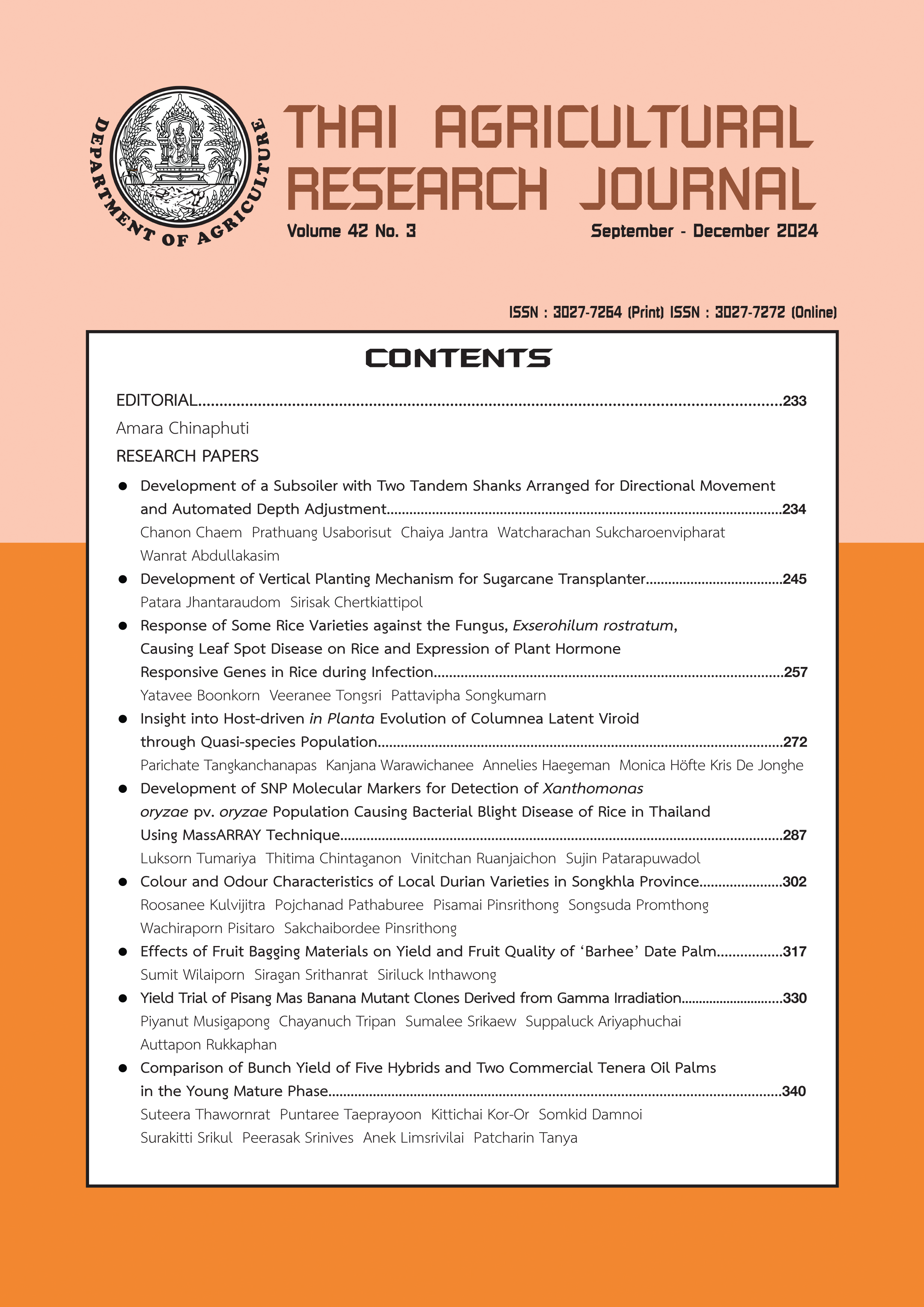Insight into Host-driven in Planta Evolution of Columnea Latent Viroid through Quasi-species Population
DOI:
https://doi.org/10.14456/thaidoa-agres.2024.22Keywords:
columnea latent viroid, quasi-species, population study, mutations, high-throughput sequencingAbstract
With a high mutation rate and fast replication, a population of mutated viroid progenies is generated and co-exists in the same host plant as a population of variants (so-called quasi-species), showing a huge level of genetic diversity. In our work, we report the evidence of the quasi-species in CLVd in several solanaceous plants; tomato (Rutgers and Seda 50), bolo maka and eggplant. An infectious dsDNA CLVd was synthesized from the recombinant plasmid containing the full-length genome of CLVd isolate Solanum-1 (JF742632) and then inoculated on the plants under specific conditions. The initial inoculation only successfully infected tomato cv. Rutgers. This CLVd-infected Rutgers was used for subsequent inoculation of the above-mentioned host plants. When all host plants proved to be systemically infected, RNA extraction and RT-PCR were performed. To study the CLVd population in individual host plants, the specific CLVd primers linked with an eight base sample-tagging sequence were used for amplifying libraries. The average 20,237 CLVd reads per PCR-replicate and 22 progeny variants in total from the first infected tomato plant were obtained. Among these 22 of CLVd variants, we found 22 total number of single-nucleotide polymorphisms in which average three point-mutations per CLVd genome mainly in Terminal Right and Pathogenic domains were observed. In addition, the estimated mutation rate of CLVd was calculated at 8.15 X10-3. Our data demonstrate that CLVd in a host plant exists as a population of quasi-species while showing host specificity of the dominant variants as host-driven in planta evolution.
References
กนกมณี ตันสุวรรณ และคนึงนิตย์ เหรียญวรากร. 2561. การถ่ายทอดเชื้อ Columnea latent viroid ผ่านทางเมล็ดของแตงกวา. วารสารวิชาการเกษตร. 36: 130–140.
ปริเชษฐ์ ตั้งกาญจนภาสน์. 2548. การตรวจสอบเชื้อไวรอยด์ในแปลงผลิตเมล็ดพันธุ์มะเขือเทศในเขตภาคตะวันออกเฉียงเหนือของประเทศไทย. วิทยานิพนธ์ปริญญามหาบัณฑิต มหาวิทยาลัยเกษตรศาสตร์. จ.นครปฐม. 85 หน้า.
ปริเชษฐ์ ตั้งกาญจนภาสน์ คนึงนิตย์ เหรียญวรากร เสริมศิริ จันทร์เปรม และรัชนี ฮงประยูร. 2548. ไพรเมอร์สำหรับตรวจสอบเชื้อไวรอยด์ที่ก่อให้เกิดโรคในมะเขือเทศ 6 ชนิด ในกลุ่ม Pospiviroid ด้วยเทคนิค RT-PCR. วารสารโรคพืช. 1(2): 13-21.
ปริเชษฐ์ ตั้งกาญจนภาสน์ คนึงนิตย์ เหรียญวรากร และวิภา เกิดพิพัฒน์. 2556. เชื้อ Columnea latent viroid (CLVd) สายพันธุ์ใหม่ที่ก่อให้เกิดอาการรุนแรงในมะอึก (Solanum stramonifolium Jacq.). วารสารวิชาการเกษตร. 31: 53–68.
ศศิประภา มาราช. 2551. โคลนก่อโรคของเชื้อ Columnea latent viroid และผลกระทบต่อมะเขือเทศพันธุ์การค้า. วิทยานิพนธ์ปริญญามหาบัณฑิต. มหาวิทยาลัยเกษตรศาสตร์. จ.นครปฐม. 86 หน้า.
Brass, J.R.J., R.A. Owens, J. Matoušek and G. Steger. 2017. Viroid quasispecies revealed by deep sequencing. RNA Biology. 14: 317–325.
Constable, F., G. Chambers, L. Penrose, A. Daly, J. Mackie, K. Davis, B. Rodoni and M. Gibbs. 2019. Viroid-infected tomato and Capsicum seed shipments to Australia. Viruses. 11(2): 98.
Ding, B. and A. Itaya. 2007. Viroid: A useful model for studying the basic principles of infection and RNA biology. Molecular Plant-microbe Interactions. 20(1): 7–20.
Dingley, A.J., G. Steger, B. Esters, D. Riesner and S. Grzesiek. 2003. Structural characterization of the 69 nucleotide potato spindle tuber viroid left-terminal domain by NMR and thermodynamic analysis. Journal of Molecular Biology. 334: 751–767.
Domingo, E., J. Sheldon and C. Perales. 2012. Viral quasispecies evolution. Microbiology and Molecular Biology Reviews. 76(2): 159–216.
Flores, R., D. Grubb, A. Elleuch, M.Á. Nohales, S. Delgado and S. Gago. 2011. Rolling-circle replication of viroids, viroid-like satellite RNAs and hepatitis delta virus: Variations on a theme. RNA Biology. 8: 200–206.
Flores, R., P. Serra, S. Minoia, F. Di Serio and B. Navarro. 2012. Viroids: From genotype to phenotype just relying on RNA sequence and structural motifs. Frontiers in Microbiology. 3: 217.
Gago-Zachert, S.. 2016. Viroids, infectious long non-coding RNAs with autonomous replication. Virus Research. 212: 12–24.
Hammond, R., D.R. Smith and T.O. Diener. 1989. Nucleotide sequence and proposed secondary structure of Columnea latent viroid: A natural mosaic of viroid sequences. Nucleic Acids Research. 17: 10083–10094.
Kalantidis, K., M.A. Denti, S. Tzortzakaki, E. Marinou, M. Tabler and M. Tsagris. 2007. Virp1 is a host protein with a major role in Potato Spindle Tuber Viroid infection in Nicotiana plants. Journal of Virology. 81(23): 12872–12880.
Keese, P. and R.H. Symons. 1985. Domains in viroids: Evidence of intermolecular RNA rearrangements and their contribution to viroid evolution. Proceedings of the National Academy of Sciences. 82(14): 4582–4586.
Kumar, S., G. Stecher and K. Tamura. 2016. MEGA7: Molecular evolutionary genetics analysis version 7.0 for bigger datasets. Molecular Biology and Evolution. 33(7): 1870–1874.
Lauring, A.S. and R. Andino. 2010. Quasispecies theory and the behavior of RNA viruses. PLoS Pathogens. 6(7): e1001005.
López-Carrasco, A., C. Ballesteros, V. Sentandreu, S. Delgado, S. Gago-Zachert, R. Flores and R. Sanjuán. 2017. Different rates of spontaneous mutation of chloroplastic and nuclear viroids as determined by high-fidelity ultra-deep sequencing. PLoS Pathogens. 13(9): e1006547.
Matsushita, Y. and S. Tsuda. 2016. Seed transmission of potato spindle tuber viroid, tomato chlorotic dwarf viroid, tomato apical stunt viroid, and Columnea latent viroid in horticultural plants. European Journal of Plant Pathology. 145: 1007–1011.
Navarro, B., A. Gisel, M.E. Rodio, S. Delgado, R. Flores and F. Di Serio. 2012. Viroids: How to infect a host and cause disease without encoding proteins. Biochimie. 94(7): 1474–1480.
Owens, R.A., D.R. Smith and T.O. Diener. 1978. Measurement of viroid sequence homology by hybridization with complementary DNA prepared in vitro. Virology. 89(2): 388–394.
Palukaitis, P., 2014. What has been happening with viroids?. Virus Genes. 49: 175–184.
Steger, G., 2017. Modelling the three-dimensional structure of the right-terminal domain of pospiviroids. Scientific Reports. 7(1): 711.
Tangkanchanapas, P., A. Haegeman, M. Höfte and K. De Jonghe. 2021. Reassessment of the Columnea latent viroid (CLVd) taxonomic classification. Microorganisms. 9: 1117.
Tangkanchanapas, P., A. Haegeman, T. Ruttink, M. Höfte and K. De Jonghe. 2020. Whole-Genome deep sequencing reveals host-driven in-planta evolution of columnea latent viroid (CLVd) quasi-species populations. International Journal of Molecular Sciences. 21(9): 3262.
Verhoeven, J.T.J., C.C.C. Jansen, T.M. Willemen, L.F.F. Kox, R.A. Owens and J.W. Roenhorst. 2004. Natural infections of tomato by Citrus exocortis viroid, Columnea latent viroid, Potato spindle tuber viroid and Tomato chlorotic dwarf viroid. European Journal of Plant Pathology. 110: 823–831.
Zhong, X., A.J. Archual, A.A. Amin and B. Ding. 2008. A genomic map of viroid RNA motifs critical for replication and systemic trafficking. The Plant Cell. 20(1): 35–47.
Downloads
Published
How to Cite
Issue
Section
License
Copyright (c) 2024 Thai Agricultural Research Journal

This work is licensed under a Creative Commons Attribution-NonCommercial-NoDerivatives 4.0 International License.
Thai Agricultural Research Journal


